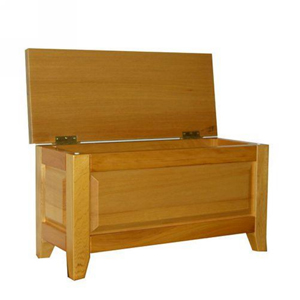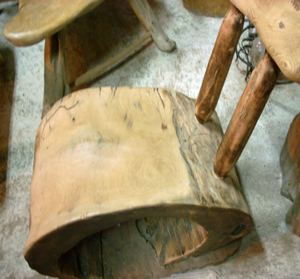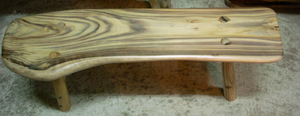Workshops Cater to Buyers with Yen for Solid Wood Furniture
2011/01/05 | By Michelle HsuLimited timber supply enhances value of pieces of homegrown Taiwanese wood

Driven by the undying passion for wooden furniture craftsmanship, a handful of makers remain in Taiwan, trying to perpetuate the trade by working within the boundaries of strict forest conservation laws, which try to preserve the indigenous wood species, especially the rarer species. And without official intervention, the timber usable for furniture making would be stripped clean for businesspeople on the island are not known to be sustainability-minded.
Local Treasures
Restricting timber supply is a blessing in disguise however. Rarity enhances value, a truism of business. So making wooden furniture out of indigenous Taiwanese timber raises added-value in such product, especially Taiwan Red Cypress, Stout Camphor, Taiwania, Taiwan Yew etc. which are regarded as local treasures.
Red cypress is among the most valuable indigenous trees in Taiwan. The high quality tactile characteristics make it a very popular wood for making high-end furniture or construction. Also it's highly resistant to moisture or weather, being highly structurally stable, as well as able to keep away termites, larvae, and worms.
Crown Red Cypress Furniture Co., Ltd. is one of the few in Taiwan committed to making the best quality Red Cypress furniture since its establishment in 1968. “Taiwan red cypress, which grows in the high mountains of Taiwan, is the best quality cypress in the world, so the company aims to make the finest wooden furniture in Taiwan,” says a company representative.
During the Japanese colonization of the island, the Japanese felled many red cypress stands, shipping some to Japan and using the rest for construction of new buildings in Taiwan. There remain decades-old buildings made of red cypress around the island.
Appreciating the value of the wood, Crown makes each piece of red cypress furniture a unique creation. “Red cypress is not a wood for mass production,” says the company, which only employs experienced craftsmen. “Some items are custom-made to match customer's interior d?cor. In fact, red cypress furniture is most prized for the wood, while carpentry only realizes the intrinsic value of the material.”
Stout Camphor
Stout camphor has become more popular and valuable as a wood for furniture making in Taiwan in recent decades, after Antrodia camphorata, the fungi growing on stout camphor, was approved as a cancer treatment. Some consumers purchase stout camphor furniture believing breathing its scent daily enhances well-being.

Camphor Home is a wooden furniture maker focused on using such wood in its products, which are billed as the only certified camphor furniture in Taiwan with patented design. Established 20 years ago, Camphor Home is dedicated to making the finest camphor furniture in Taiwan. According to the company, camphor has always been the wood of choice to make Buddha sculptures for its unique scent and durability based on insect-repelling capacity, with the wood having become even more appealing due to its cancer-fighting property.
Taiwan Yew and Taiwania
Taiwan yew and Taiwania are two other indigenous woods on the island with high economic value, but also have been in short supply over the last decades as the other native species. “Due to the government's forest protection policy, we don't buy new wood, but recycle used wood,” says Hsu Chin-wen, who runs a workshop that turns ‘useless' discarded wooden furniture or products into usable pieces through creative design. “In other words, we give ‘abandoned' wood a new lease on life,” Hsu adds.

Taiwan yew is one of Taiwan's most valuable woods widely used to make Buddha sculptures, furniture or architectural items. Its bark and leaves have been proven to contain anti-cancer ingredients and are increasingly used in the medical industry.
In contrast to Taiwan yew's shrinking supply for the furniture industry, “Taiwania is much more available in Taiwan now,” observes Hsu, who has just completed several pieces in the wood featuring its distinctive deep-colored grain. The wood is soft, but durable and attractively spicy scented.
Naturally Wood
Unlike most wooden furniture products, which are made of a mixture of laminated and reconstituted woods, Hsu says solid wood furniture is primarily valued for being made of sawn timber, with carpentry employed to preferably show the natural beauty of wooden grain and texture. Typically solid wood furniture is made to be unique. Hsu recently made several pieces of camphor furniture which were among his best-sellers due to consumers' strong preference for the wood. When using the lucrative camphor, Hsu tries to minimize fancy design, aiming to keep the pieces simple so as not to detract from the wood's natural aesthetics. His creation of a camphor chair made with a hollow camphor truck, for example, shows an original approach.
There are no furniture makers in Taiwan engaged in mass production of wooden furniture. Nonetheless, there are a considerable number of workshops specializing in solid wood furniture making, mostly small scale, supplying high quality and mainly custom-made pieces to customers with a penchant for solid wood furniture.




